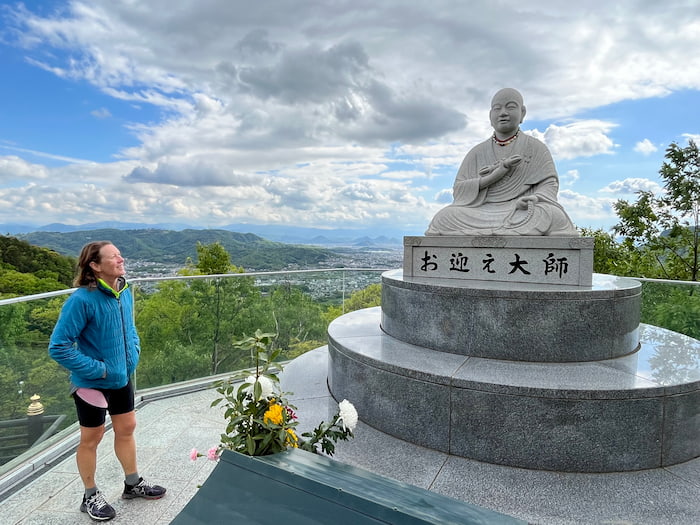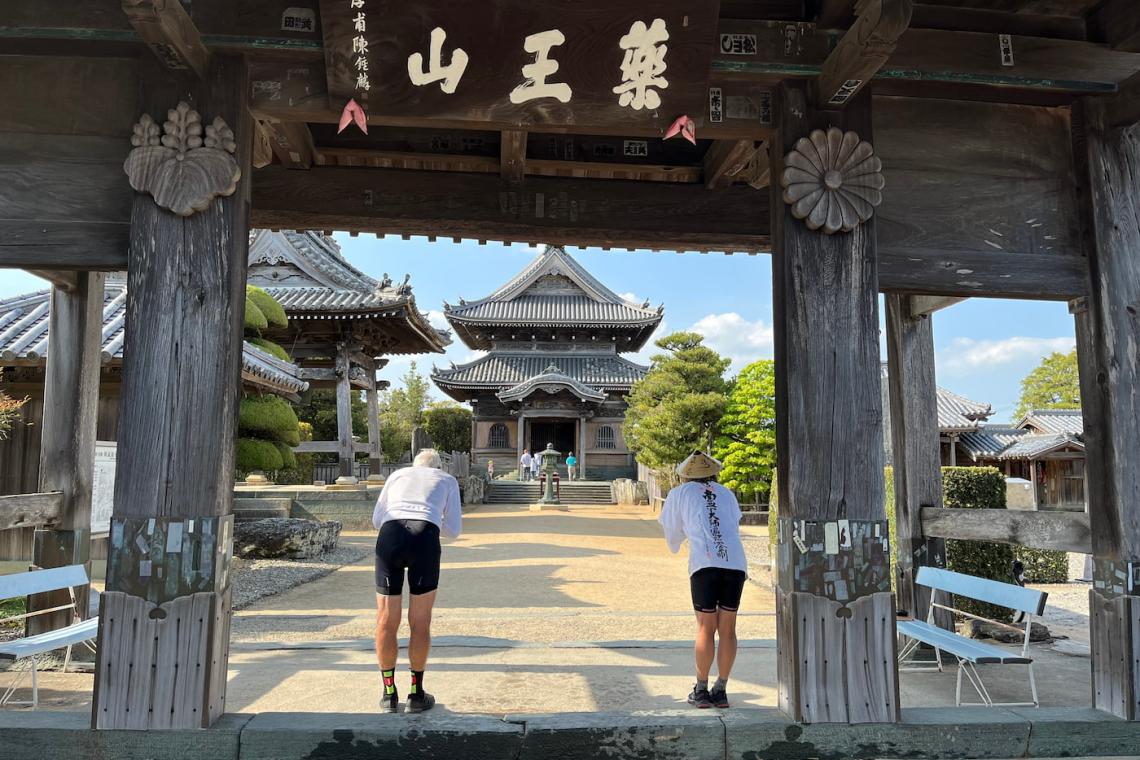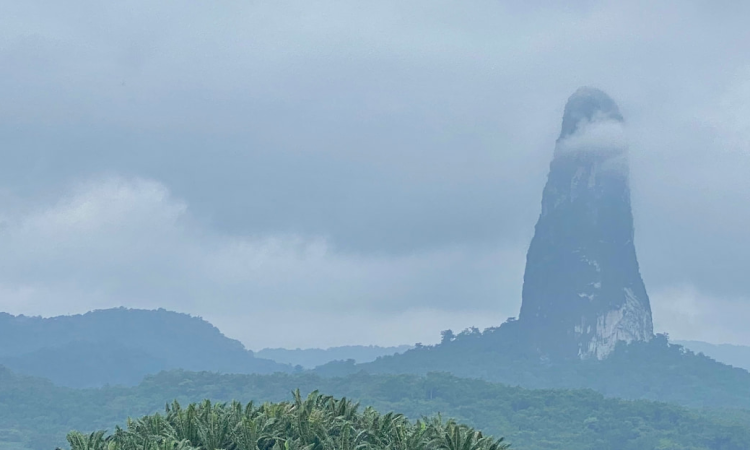
My wife, Fiona, and I had come to Shikoku, the smallest of Japan’s four main islands, to tackle the historic 88 Temple pilgrimage. While its origins are obscure, the mission is closely associated with an 8th century monk who started life as Mao Saeki, rebranded himself Kukai (‘sky and sea’), and was posthumously renamed Kobo Daishi (‘the grandmaster who propagated dharma’). Born in 774, at a time when Japan was plagued by strife and smallpox, Kukai wisely spent his formative years meditating in remote spots. After a study trip to China in 804, he returned home to spread Esoteric Buddhism, now one of Japan’s most popular religions, alongside the equally esoteric Shinto.
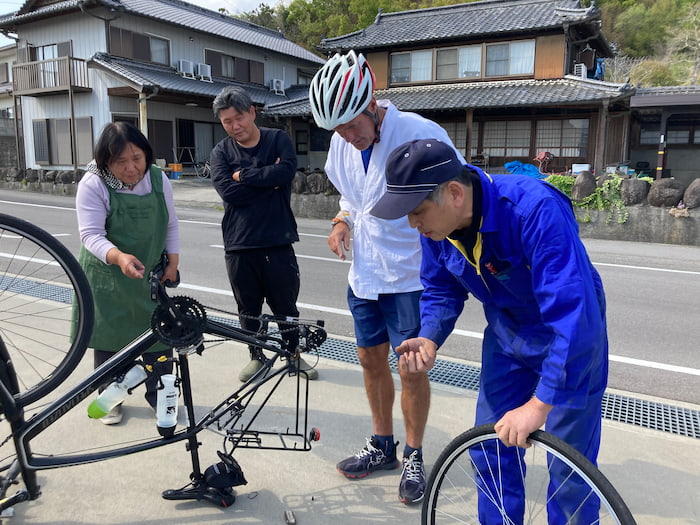
Like most aspiring ‘henros’, or pilgrims, we started from Tokushima, on Shikoku’s east coast. While there’s no mandatory route – provided you visit all 88 temples – most henros undertake a clockwise circuit around the island’s perimeter, with a few inland forays. The majority of temples are clustered around towns, a few on remote peninsulas, and over a dozen perched atop lofty peaks - with the most inaccessible eight designated as ‘nanshos’, or ‘difficult places.’ The pilgrimage typically takes over 40 days on foot, with the majority spent on asphalt. Fortunately, an internet search unearthed Norman White - a former restauranteur turned cycle tour operator – who kitted us out with hybrid bikes, waterproof panniers and puncture-repair kits.
You may also like Cycling The Hebridean Way: Travelling in Outer Space.
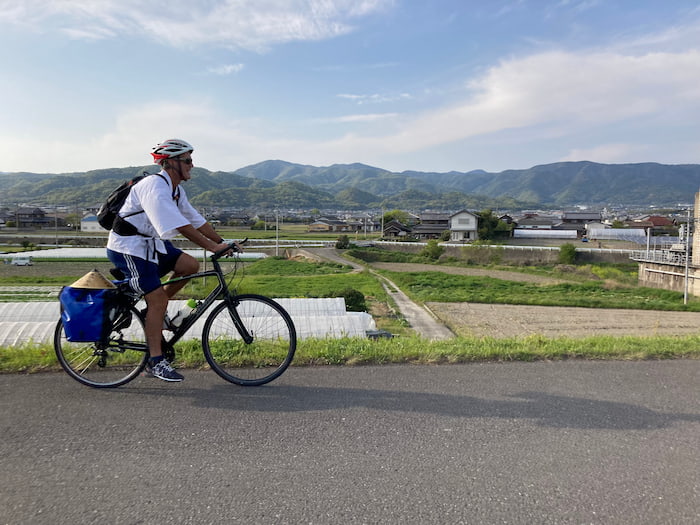
More by Matthew
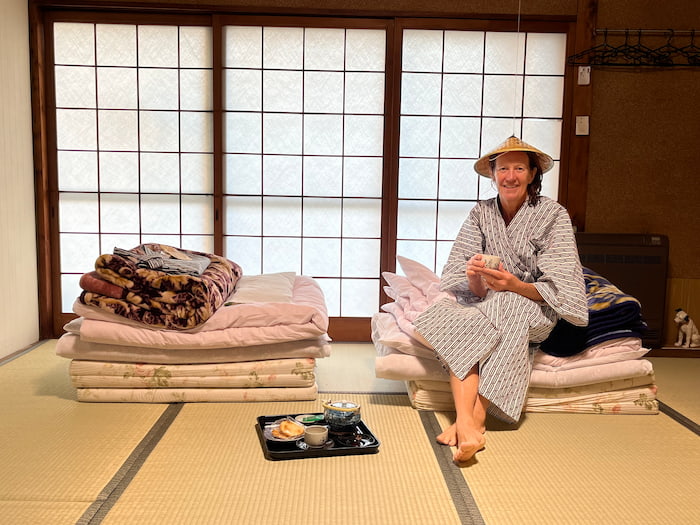
While all 88 temples claim a close affinity with Kukai, he probably only visited a handful. Instead, the first recorded pilgrimage was completed in 1687 by an intrepid monk, Yuben Shinnen, who numbered the temples, organised signposts and wrote the first guidebook - though we procured a more recent route map in English from the Tokushima tourist office.
Cycling out from Tokushima, we passed billboards advertising brands that in the 1980s looked set to conquer the world, but then subsequently shrivelled, along with Japan’s economy and population. With over one-quarter of the Japanese past retirement age, we felt like sprightly youngsters.
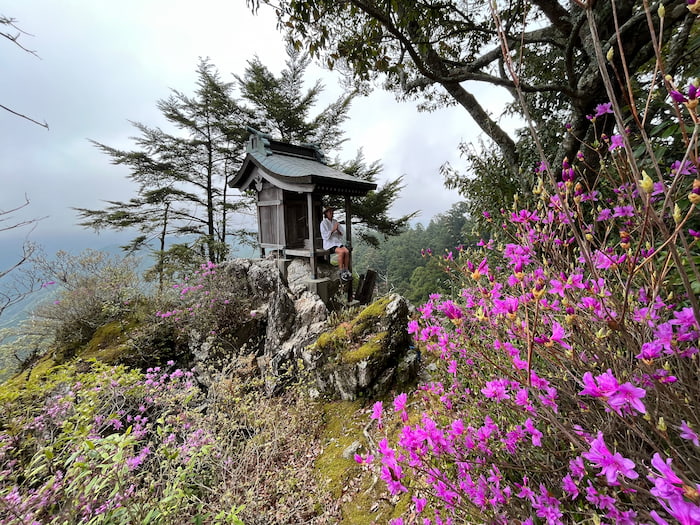

Some 30km in, we got to practise puncture repairs, when a nail penetrated my back wheel. Rumbling to a halt outside a citrus farm, the owners shuffled over to offer us oranges and spectate, as I fumbled haplessly with tyre levers and Richmond sliced his thumb open, peeling said oranges with his penknife. Presumably fearing we’d never leave, they telephoned a local mechanic, who arrived by van and swiftly repaired my bike, declining payment. At the next temple, where Kukai had enlightened a samurai’s disgraced mistress, I prayed for citrus farmers, mechanics and the kindness of strangers.
Once we found our cycling legs, we rattled off over 80km daily. Though wary of developing a stage-race mentality, we didn’t want to lose momentum, especially while the weather held. We’d come in early April, typically a warm, dry month between the chilly winter and summer typhoons - and during our three-week trip, it rained only twice, though on those days, we did get a drenching. The other spur to our schedule was the impending Golden Week at the end of the month, when the entire Japanese nation takes holiday, and everything is fully booked.
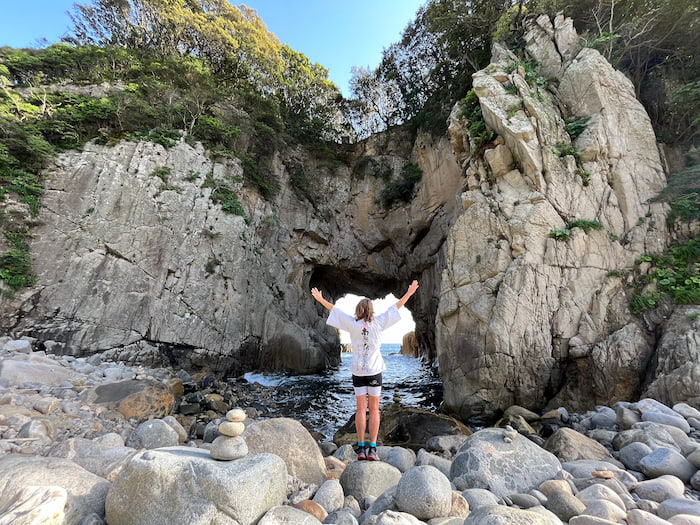
We mainly stayed in ryokans – traditional inns - with paper screen walls, tatami floors, futon bedrolls and communal baths, which seemed as essentially Japanese as saunas in Scandinavia. And we generally dined in izakayas – traditional family-run taverns – on sashimi and tempura, which was freshly prepared and artfully served, if difficult to digest sitting cross-legged on the floor. Breakfasts were also exquisitely presented, but dried fish, rice and a raw egg didn’t quite hit the spot - and we’d rather seek convenience stores enroute for more familiar milk coffees and chocolate buns.
On our eighth day, we departed Iwamotoji, heading for Temple 38 on Cape Ashizuri, some 82km away, which was the longest gap between temples. On a bluebird day, we cycled besides pristine beaches and through small fishing villages, and it was only the outsized harbour walls and regular tsunami evacuation towers that suggested life here wasn’t always an idyllic cliche.
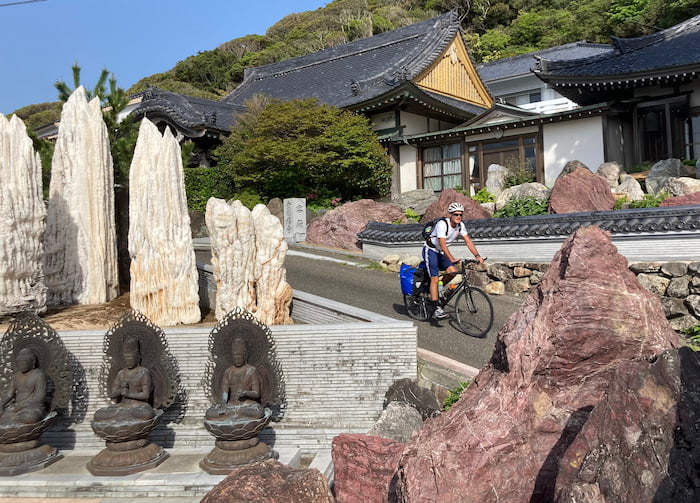
Shikoku’s southernmost point, Cape Ashizuri was a splendid spot, with sheer cliffs, surf-battered sea-arches, an improbably perched lighthouse, and a characterful temple – the tongue-twisting Kongofukuji, or Temple of Eternal Happiness. Outside the temple stood a statue of local lad John Manjiro, born during the so-called Edo Period, when Japan was a feudal regime under the Shogunate, and contact with foreigners was a capital offence. In 1841, aged 14, Manjiro went on a fishing trip, only to be shipwrecked on an uninhabited isle. Rescued by an American whaler, he continued to Massachusetts, learned English and made his fortune gold prospecting. A decade later, he purchased a ship and returned home, notwithstanding the risk. However, after being interrogated, he was spared, promoted to samurai status and – as the only English-speaking native – used as translator in the Shogunate’s negotiations with an American naval expedition, which arrived in 1853 and forcefully opened up Japan to international trade. The ensuing national humiliation prompted Japan’s rapid industrialisation, militarisation, invasion of Manchuria and attack on Pearl Harbour - but it would be unfair to blame all this on John Manjiro.
After 10 days, we’d ticked off 43 temples and over half the distance, but Richmond still couldn’t manipulate chopsticks and none of us had mastered the slipper protocol. On entering Japanese abodes, you’re expected to remove your shoes and don specific sets of doll-sized slippers in different parts of the house. At one ryokan, crossing the threshold, visiting the loo and returning to our bedroom required six footwear changes. To us gaijins, Japan was a baffling mix of ancient and modern. The temples had cardboard cartoon characters directing us where to chant ancient sutras; while the ryokans had paper walls and slipper rules, plus heated toilets with more controls than a Boeing 747.
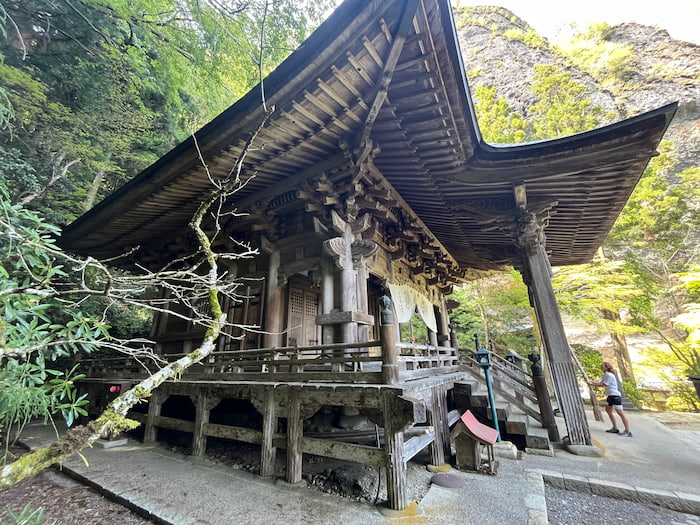
Our white hakui shirts symbolised our purity and, more accurately, readiness for death. In this regard, the road tunnels seemed particularly perilous: sometimes several kilometres long, with articulated lorries brushing our panniers. As it was, however, most of our close shaves were in cities and entirely self-inflicted. Japanese cyclists and pedestrians sedately share sidewalks, religiously obey traffic lights and were quite nonplussed as Richmond burst through red lights, weaving between fenders like a matador, with Fiona and I slaloming through the carnage in his wake. In most other countries, we’d have been imprisoned or killed, but thankfully Japanese motorists are very forgiving.
Virtually every temple had a unique purpose. For example, at Temple 41 you could pray for lost pets, at Temple 52 for avoiding pregnancy, at Temple 84 for getting pregnant, and at Temple 83 for your car. More pertinently, at Temple 3, if you look into the well, constructed by Kukai, and can’t see your reflection, then your time is almost up. Fortunately, it was noon and sunny when I chanced it.
On reaching Saijo City, after a fortnight, we took a day off, though we foolishly left organising our R&R to Fiona, who had us climbing Mount Ishizuchi, Shikoku’s high point at 1982m. With long metal chains, greasy rockfaces and a precarious summit ridge, the route was exciting - especially for Richmond, in his cleated cycling shoes. As with most of the island’s prominent perches, Kukai is said to have meditated on top.

The stretch between Kanonnji and Takamatsu was Kukai’s hood, with Temple 71 housing a cave where he’d meditated, Temple 73 beneath a cliff he’d flung himself off (to check a buddha would save him), and Temple 75 next to his family home. Indeed, the temples came so thick and fast around here that we notched up 13 in a day - although this was more of an ergonomic than religious achievement. Notwithstanding its historic religious surrounds, Takamatsu was a bland, modern city, having been flattened by a US air raid during WW2. We took this opportunity to check into a business hotel, which lacked the cultural immersion of a ryokan, but did have furniture above shin height. For good measure, we sought out an Italian restaurant.
An estimated 150,000 undertake the 88 Temple pilgrimage annually, predominantly Japanese in buses or cars. Somewhat surprisingly, we didn’t meet any other henros on cycles, though we did pass plenty on foot, hobbling along in white shirts and sedge hats – confirming our route and chosen mode of transport.
On our 18th day, we left Takamatsu in early morning sunshine and rush hour traffic, with a light breeze on our tail and stout 95km ahead. The main challenge was finding Temple 88, Okuboji, which was somewhere on the far side of Mount Nyotai, beyond a 700m-high ridge. Richmond claimed to have plotted a clever course via forest tracks, with no road traffic and a gradual ascent - and for a while we believed him, till we’d been grinding for several hours up a gradient over 10%. I’ll even admit to a pang of despair when he dismounted and admitted he was lost. Still, trials and tribulations are the test of faith, and freewheeling down an unprepossessing dirt track, we miraculously emerged on the temple’s doorstep.
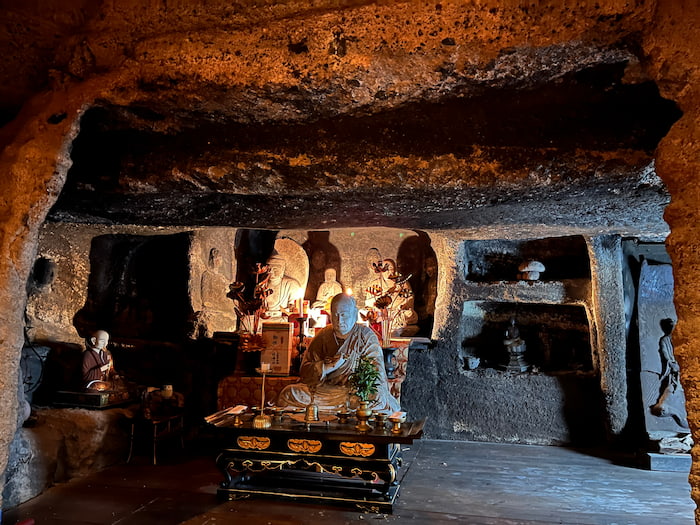
Nestled on Mount Nyotai’s leafy, south flank, Okuboji would have made for a fitting finale, but for the inconvenient concept of ‘ore imairi,’ or closing the loop. For to have credibility with fellow henros, you must finish at your starting point; in our case, Ryozenji, some 45km away. As it was, returning to Temple 1 was anticlimactic. The Heart Sutra still had me baffled, and the nonagenarian calligrapher in the nokyocho tried to charge double for signing my book. But, no matter, our pilgrimage still wasn’t over, for we now had to travel to Koyasan, the mountain temple complex on Honshu, where Kukai has been resting in eternal meditation since 835, at the mandala of the Womb and Diamond Realms. And thereafter, I could always continue around the 88 temples, with many henros having completed a century of circuits on their quest for enlightenment. For most of us, a pilgrimage is more about the journey than arrival.
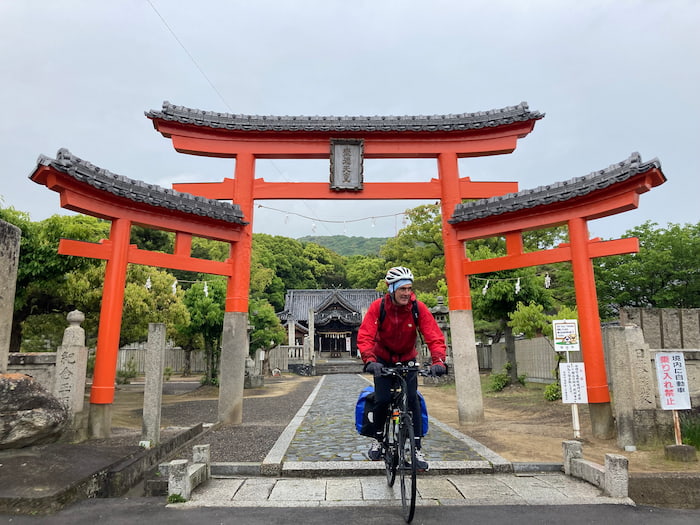
Tips for Aspiring Henros
When to Go: The best periods are March to April (avoiding Golden Week), and October to November. December to February is dry but cold; May to August is hot and wet; September is typhoon season.
Getting There: You can theoretically drop in wherever you like, but most henros start at Temple 1, a 30-minute train ride from Tokushima. The nearest international airport is Kansai, from where it’s a 3½-hour bus ride to Tokushima. A popular henro haunt in Tokushima is Hostel PAQ, which has a variety of accommodation options: hostelpaq.com
Cycling or Hiking: The classic hiking circuit is 1150km, taking most henros 40-50 days to complete. On cycles, sticking to roads, we clocked 1430km from/to Tokushima. Cycle Shikoku offers 21-day rental packages, including panniers, helmets, etc from JY 40,000 (US$ 285): cycleshikoku.com.
Route Finding: The henro bible is ‘Shikoku Japan 88 Route Guide’, which is updated annually, and shows the hiking trail and roads, plus convenience stores and accommodation. You can purchase it at the Tokushima Tourism Office (opposite the train and bus stations). Don’t lose it or you’re doomed. For non-Japanese speakers, the main challenge is securing accommodation outside main towns. Once you’ve managed to get started, ask your host to book one night ahead. You could take a tent, but good luck asking where you can pitch it. ‘The 88 Temples of Shikoku’ by Oliver Dunskus has interesting background information on each temple.
